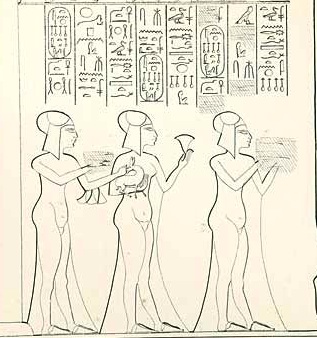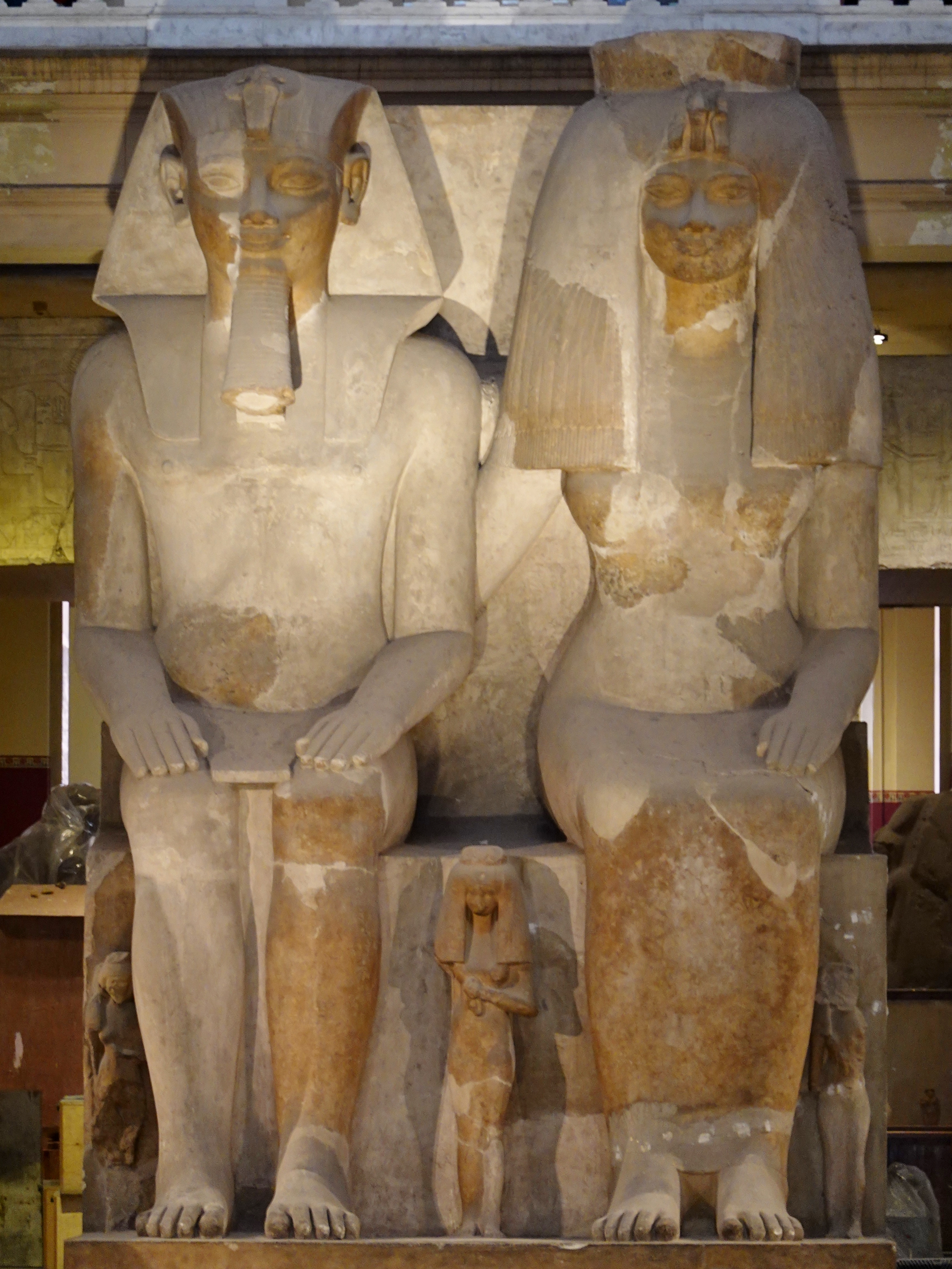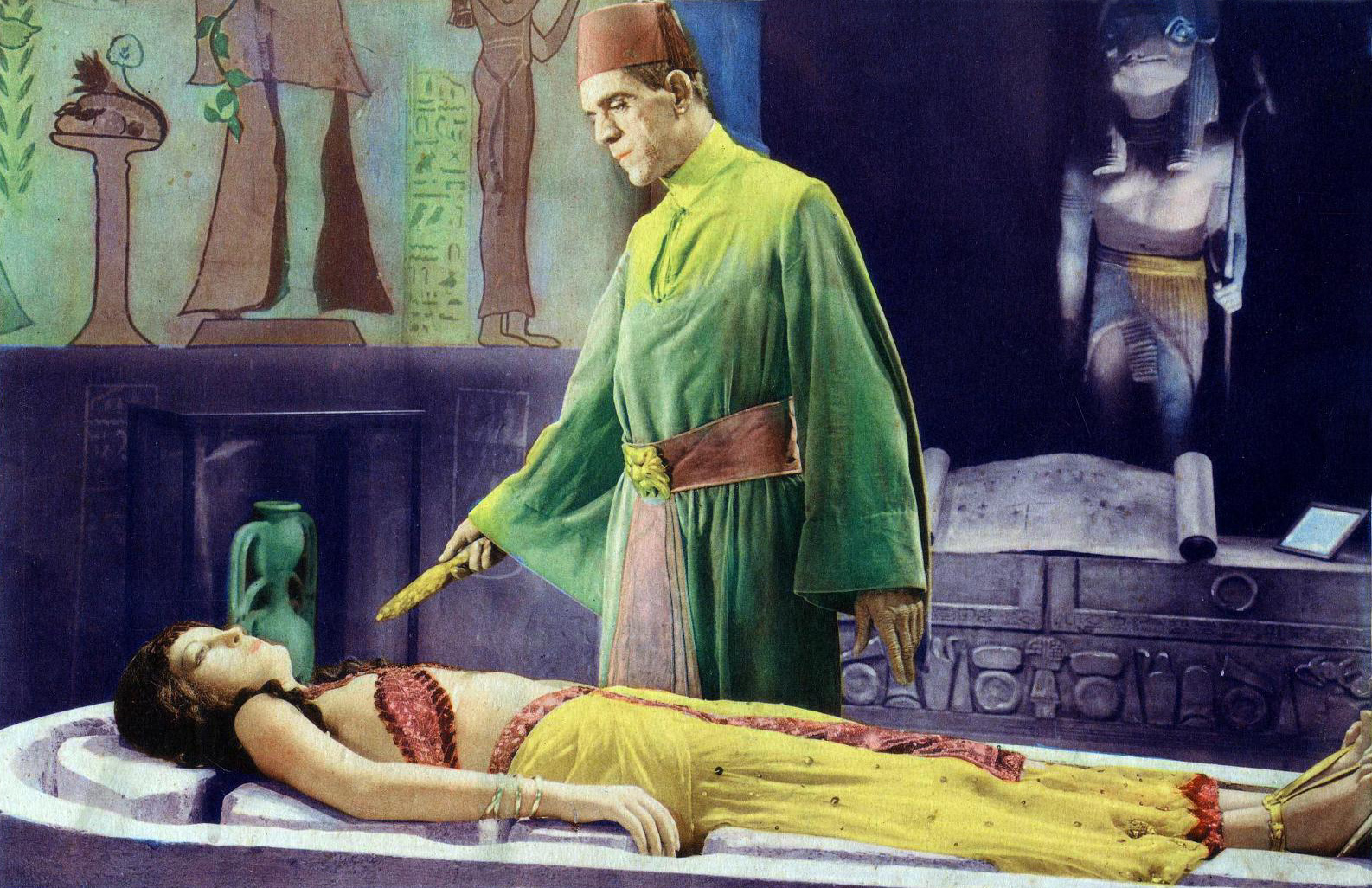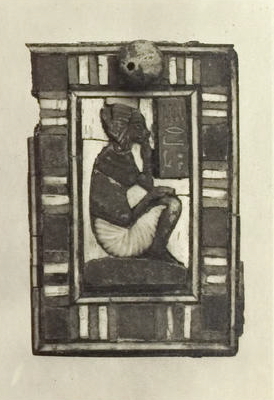|
Meketaten
Meketaten ("Behold the Aten" or "Protected by Aten") was the second daughter of six born to the Egyptian Pharaoh Akhenaten and his Great Royal Wife Nefertiti. She likely lived between Year 4 and Year 14 of Akhenaten's reign. Although little is known about her, she is frequently depicted with her sisters accompanying her royal parents in the first two-thirds of the Amarna Period. Biography Meketaten was born approximately in Year 4 of Akhenaten's reign to that pharaoh and his Great Royal Wife, Nefertiti.Tyldesley, Joyce. Nefertiti: Egypt's Sun Queen. Penguin. 1998. She had an elder sister, Meritaten, and four younger sisters: Ankhesenpaaten, Neferneferuaten Tasherit, Neferneferure and Setepenre. Tutankhaten was likely a full or half-brother through their father. Her birth year is estimated based on the dates of inscriptions that reference her. The first known depiction of Meketaten is on the walls of the ''Hwt-benben'' temple in Thebes, which is dedicated to her mother Nefertiti. ... [...More Info...] [...Related Items...] OR: [Wikipedia] [Google] [Baidu] |
Akhenaten
Akhenaten (pronounced ), also spelled Echnaton, Akhenaton, ( egy, ꜣḫ-n-jtn ''ʾŪḫə-nə-yātəy'', , meaning "Effective for the Aten"), was an ancient Egyptian pharaoh reigning or 1351–1334 BC, the tenth ruler of the Eighteenth Dynasty. Before the fifth year of his reign, he was known as Amenhotep IV ( egy, jmn-ḥtp, links=no, meaning " Amun is satisfied", Hellenized as ''Amenophis IV''). As a pharaoh, Akhenaten is noted for abandoning Egypt's traditional polytheism and introducing Atenism, or worship centered around Aten. The views of Egyptologists differ as to whether the religious policy was absolutely monotheistic, or whether it was monolatry, syncretistic, or henotheistic. This culture shift away from traditional religion was reversed after his death. Akhenaten's monuments were dismantled and hidden, his statues were destroyed, and his name excluded from lists of rulers compiled by later pharaohs. Traditional religious practice was gradually restor ... [...More Info...] [...Related Items...] OR: [Wikipedia] [Google] [Baidu] |
Nefertiti
Neferneferuaten Nefertiti () ( – c. 1330 BC) was a queen of the 18th Dynasty of Ancient Egypt, the great royal wife of Pharaoh Akhenaten. Nefertiti and her husband were known for a radical change in national religious policy, in which they promoted a form of proto-monotheism centred on the sun god Aten. With her husband, she reigned at what was arguably the wealthiest period of ancient Egyptian history. Some scholars believe that Nefertiti ruled briefly as Neferneferuaten after her husband's death and before the ascension of Tutankhamun, although this identification is a matter of ongoing debate.Dodson, Aidan, Amarna Sunset: ''Nefertiti, Tutankhamun, Ay, Horemheb, and the Egyptian Counter-Reformation''. The American University in Cairo Press. 2009, . If Nefertiti did rule as Pharaoh, her reign was marked by the fall of Amarna and relocation of the capital back to the traditional city of Thebes. She was made famous by her bust, now in Berlin's Neues Museum. The bu ... [...More Info...] [...Related Items...] OR: [Wikipedia] [Google] [Baidu] |
Royal Tomb Of Akhenaten
The Royal Tomb of Akhenaten, located in the Royal Wadi at Amarna, is the burial place of the Eighteenth Dynasty pharaoh Akhenaten. Layout A flight of twenty steps, with a central inclined plane leads to the door and a long straight descending corridor. Halfway down this corridor a suite of unfinished rooms (perhaps intended for Nefertiti). The main corridor continues to descend, and to the right again a second suite of rooms branches off. The corridor then descends via steps into an ante-room, and then to the pillared burial chamber where his granite sarcophagus sat in a slight dip in the floor. It was decorated by carvings of Nefertiti acting as a protective goddess, and by the ever-present sun-disks of the Aten. Decoration The second suite of three chambers (referred to as Alpha, Beta and Gamma) are believed to be used for the burial of Meketaten, Akhenaten's second daughter. Two of the chambers (Alpha and Gamma) are decorated and depict very similar scenes: in the Alpha ch ... [...More Info...] [...Related Items...] OR: [Wikipedia] [Google] [Baidu] |
Boundary Stelae Of Akhenaten
The Boundary Stelae of Akhenaten are a group of royal monuments in Upper Egypt. They are carved into the cliffs surrounding the area of Akhetaten, or the Horizon of Aten, which demarcates the limits of the site. The Pharaoh Akhenaten commissioned the construction of Akhetaten in year five of his reign during the New Kingdom. It served as a sacred space for the god Aten in an uninhabited location roughly halfway between Memphis and Thebes at today's Tell El-Amarna. The boundary stelae include the foundation decree of Akhetaten along with later additions to the text, which delineate the boundaries and describe the purpose of the site and its founding by the Pharaoh. Total of sixteen stelae have been discovered around the area. According to Barry Kemp, the Pharaoh Akhenaten did not “conceive of Akhetaten as a city, but as a tract of sacred land”. Discovery and publication Sixteen boundary stelae have so far been discovered at Tell El-Amarna. The French Jesuit Claude Sicard was ... [...More Info...] [...Related Items...] OR: [Wikipedia] [Google] [Baidu] |
Neferneferuaten Tasherit
Neferneferuaten Tasherit or Neferneferuaten the younger (14th century BCE) was an ancient Egyptian princess of the 18th Dynasty and the fourth daughter of Pharaoh Akhenaten and his Great Royal Wife Nefertiti. Family Neferneferuaten was born between ca. year 8 and 9 of her father's reign. She was the fourth of six known daughters of the royal couple. It is likely that she was born in Akhetaten, the capital founded by her father. Her name ''Neferneferuaten'' ("Beauty of the Beauties of Aten" or "Most Beautiful One of Aten") is the exact copy of the name Nefertiti took in the 5th regnal year. ("Ta-sherit" simply means "the younger").Tyldesley, Joyce. Nefertiti: Egypt's Sun Queen. Penguin. 1998. She had three older sisters named Meritaten, Meketaten, and Ankhesenpaaten (later known as Ankhesenamun), and two younger sisters named Neferneferure and Setepenre.Dodson, Aidan and Hilton, Dyan. The Complete Royal Families of Ancient Egypt. Thames & Hudson. 2004. Life One of the ea ... [...More Info...] [...Related Items...] OR: [Wikipedia] [Google] [Baidu] |
Tiye
Tiye (c. 1398 BC – 1338 BC, also spelled Tye, Taia, Tiy and Tiyi) was the daughter of Yuya and Thuya. She became the Great Royal Wife of the Egyptian pharaoh Amenhotep III. She was the mother of Akhenaten and grandmother of Tutankhamun. In 2010, DNA analysis confirmed her as the mummy known as "The Elder Lady" found in the tomb of Amenhotep II ( KV35) in 1898. Family and early life Tiye's father, Yuya, was a non-royal, wealthy landowner from the Upper Egyptian town of Akhmim, where he served as a priest and superintendent of oxen or commander of the chariotry. Tiye's mother, Thuya, was involved in many religious cults, as her different titles attested (''Singer of Hathor'', ''Chief of the Entertainers'' of both Amun and Min...), which suggests that she was a member of the royal family. Egyptologists have suggested that Tiye's father, Yuya, was of foreign origin due to the features of his mummy and the many different spellings of his name, which might imply it was a non- ... [...More Info...] [...Related Items...] OR: [Wikipedia] [Google] [Baidu] |
Queen Tiye
Tiye (c. 1398 BC – 1338 BC, also spelled Tye, Taia, Tiy and Tiyi) was the daughter of Yuya and Thuya. She became the Great Royal Wife of the Egyptian pharaoh Amenhotep III. She was the mother of Akhenaten and grandmother of Tutankhamun. In 2010, DNA analysis confirmed her as the mummy known as "The Elder Lady" found in the tomb of Amenhotep II ( KV35) in 1898. Family and early life Tiye's father, Yuya, was a non-royal, wealthy landowner from the Upper Egyptian town of Akhmim, where he served as a priest and superintendent of oxen or commander of the chariotry. Tiye's mother, Thuya, was involved in many religious cults, as her different titles attested (''Singer of Hathor'', ''Chief of the Entertainers'' of both Amun and Min...), which suggests that she was a member of the royal family. Egyptologists have suggested that Tiye's father, Yuya, was of foreign origin due to the features of his mummy and the many different spellings of his name, which might imply it wa ... [...More Info...] [...Related Items...] OR: [Wikipedia] [Google] [Baidu] |
Setepenre (princess)
Setepenre or Sotepenre ( egy, stp-n-rꜥ "chosen of Re") was an ancient Egyptian princess of the 18th Dynasty; sixth and last daughter of Pharaoh Akhenaten and his chief queen Nefertiti., p.156 Family Setepenre was born around the 9thTyldesley, Joyce. Nefertiti: Egypt's Sun Queen. Penguin. 1998. to 11th year of her father Akhenaten in the city of Akhetaten.Aldred, Cyril, Akhenaten: King of Egypt ,Thames and Hudson, 1991 (paperback), She had five older sisters named Meritaten, Meketaten, Ankhesenpaaten, Neferneferuaten Tasherit, and Neferneferure.Dodson, Aidan and Hilton, Dyan. The Complete Royal Families of Ancient Egypt. Thames & Hudson. 2004. Life One of the earliest depictions of Setepenre is in a fresco from the King’s House in Amarna. She is depicted sitting on her mother Nefertiti's lap. The fresco is much damaged and only a small hand of Setepenre remains. The fresco is dated to ca. year 9 of Akhenaten, and the entire family is depicted. The next time the six pri ... [...More Info...] [...Related Items...] OR: [Wikipedia] [Google] [Baidu] |
Meritaten
Meritaten, also spelled Merytaten, Meritaton or Meryetaten ( egy, mrii.t-itn) (14th century BC), was an ancient Egyptian royal woman of the Eighteenth Dynasty of Egypt. Her name means "She who is beloved of Aten"; Aten being the sun-deity whom her father, Pharaoh Akhenaten, worshipped. She held several titles, performing official roles for her father and becoming the Great Royal Wife to Pharaoh Smenkhkare, who may have been a brother or son of Akhenaten. Meritaten also may have served as pharaoh in her own right under the name Ankhkheperure Neferneferuaten.J. Tyldesley, ''Chronicle of the Queens of Egypt'', 2006, Thames & Hudson, pg 136–137 Family Meritaten was the first of six daughters born to Pharaoh Akhenaten and his Great Royal Wife, Nefertiti. Her sisters are Meketaten, Ankhesenpaaten, Neferneferuaten Tasherit, Neferneferure, and Setepenre. Meritaten is mentioned in diplomatic letters, by the name ''Mayati''. She is mentioned in a letter from Abimilki of Tyre. The refe ... [...More Info...] [...Related Items...] OR: [Wikipedia] [Google] [Baidu] |
Ankhesenpaaten
Ankhesenamun (, "Her Life Is of Amun"; c. 1348 or c. 1342 – after 1322 BC) was a queen who lived during the 18th Dynasty of Egypt as the pharaoh Akhenaten's daughter and subsequently became the Great Royal Wife of pharaoh Tutankhamun. Born Ankhesenpaaten (, "she lives for the Aten"), she was the third of six known daughters of the Egyptian Pharaoh Akhenaten and his Great Royal Wife Nefertiti. She became the Great Royal Wife of Tutankhamun. The change in her name reflects the changes in ancient Egyptian religion during her lifetime after her father's death. Her youth is well documented in the ancient reliefs and paintings of the reign of her parents. The mummy of Tutankhamun's mother has been identified through DNA analysis as a full sister to his father, the unidentified mummy found in tomb KV55, and as a daughter of his grandfather, Amenhotep III. So far his mother's name is uncertain, but her mummy is known informally to scientists as the Younger Lady. Ankhesenamun was well ... [...More Info...] [...Related Items...] OR: [Wikipedia] [Google] [Baidu] |
Neferneferure
Neferneferure ( egy, nfr-nfr.w-rꜥ "beautiful are the beauties of Re") (14th century BCE) was an ancient Egyptian princess of the 18th Dynasty. She was the fifth of six known daughters of Pharaoh Akhenaten and his Great Royal Wife Nefertiti. Family Neferneferure was born in or before the 8th regnal year of her father Akhenaten in the city of Akhetaten.Tyldesley, Joyce. Nefertiti: Egypt's Sun Queen. Penguin. 1998. She had four older sisters named Meritaten, Meketaten, Ankhesenpaaten and Neferneferuaten Tasherit, as well as a younger sister named Setepenre.Dodson, Aidan and Hilton, Dyan. The Complete Royal Families of Ancient Egypt. Thames & Hudson. 2004. Life One of the earliest depictions of Neferneferure is in a fresco from the King's House in Amarna. She is depicted sitting on a pillow with her sister Neferneferuaten Tasherit. The fresco is dated to ca. year 9 of Akhenaten, and the entire family is depicted, including the baby Setepenre. Neferneferure is depicted at ... [...More Info...] [...Related Items...] OR: [Wikipedia] [Google] [Baidu] |
Kiya
Kiya was one of the wives of the Egyptian Pharaoh Akhenaten. Little is known about her, and her actions and roles are poorly documented in the historical record, in contrast to those of Akhenaten's ‘Great royal wife’, Nefertiti. Her unusual name suggests that she may originally have been a Mitanni princess.Reeves, C. Nicholas. ''New Light on Kiya from Texts in the British Museum'', p.100 The Journal of Egyptian Archaeology, Vol. 74 (1988) Surviving evidence demonstrates that Kiya was an important figure at Akhenaten's court during the middle years of his reign, when she had a daughter with him.William J. Murnane. ''Texts from the Amarna Period in Egypt.'' Edited by E.S. Meltzer. Atlanta: Society of Biblical Literature, 1995. () Page 9, pp 90–93, pp 210–211.Aidan Dodson. Amarna Sunset: Nefertiti, Tutankhamun, Ay, Horemheb, and the Egyptian Counter Reformation. The American University in Cairo Press, 2009. () Page 17. She disappears from history a few years before her royal h ... [...More Info...] [...Related Items...] OR: [Wikipedia] [Google] [Baidu] |







